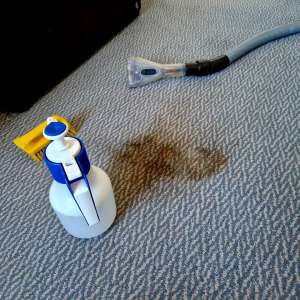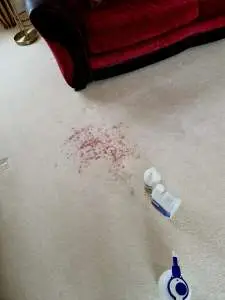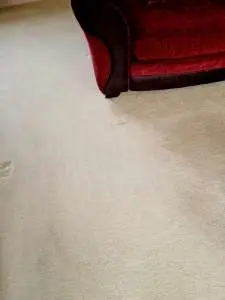We all understand that regular carpet cleaning is a good idea, but, what are the top six factors contributing to domestic carpet soiling?
- Pets. Pet hair, dander, and urine are some of the most common causes of carpet soiling. If you have pets, it is important to vacuum regularly and spot-clean any accidents immediately.
- Foot traffic. The more people who walk on your carpet, the more dirt and grime it will collect. This is especially true if you live in an area with a lot of traffic, such as near a busy road or in a high-rise building.
- Food and drink spills. It is easy to spill food and drinks on your carpet, especially if you have children or frequent guests. These spills can quickly stain and set into the carpet fibres, so it is important to clean them up as soon as possible.
- Dust and dirt. Dust and dirt can easily accumulate in your carpet, especially if you live in a dusty or dirty environment. This can make your carpet look dull and dingy, and it can also be a health hazard.
Mould and mildew. If your carpet is wet or damp, it can create a breeding ground for mould and mildew. This can cause your carpet to smell bad and it can also be a health hazard.
- Location. The location of your home can also contribute to carpet soiling. For example, if you live near a busy road, your carpet may be more likely to collect traffic dust. We find more sand content when we are carpet cleaning in Seaford or other coastal towns, particularly if dogs are living in a property.
Pets – how they contribute to domestic carpet soiling
We love our pets, cats and dogs are often an important member of our family.
Unfortunately, pets can significantly affect the soiling levels in our homes. Here are some of the ways that pets can contribute to soiling:
Fur and dander. Pet hair and dander are very small and can easily become airborne. They can settle on furniture, carpets, and other surfaces, making them look dirty and dusty. In some people, pet hair and dander can also trigger allergies or asthma.
Urine and faeces. Pet urine and faeces can contain bacteria and other harmful substances. If they are not cleaned up properly, they can cause health problems for people and pets. They can also create a foul odour that can be difficult to remove.
Animal claws. Pet claws can scratch carpets and furniture, causing them to become damaged.
Saliva. Pet saliva can contain bacteria that can cause stains and odours.
The amount of soiling that pets cause will vary depending on the type of pet, the size of the pet, and the pet’s behaviour. For example, dogs that are housebroken are less likely to soil carpets than dogs that are not house trained.

Animals love our carpets. They spend a lot of their time sleeping, playing and sometimes eating on them.
Its inevitable that they will have a soiling effect in the carpet fibres. This image was taken whilst upholstery cleaning. A beautiful cat rolling around on carpets.
Its also important to avoid using aggressive and toxic carpet cleaning solutions too. Animals are particularly sensitive to aggressive chemicals.
Using the latest carpet cleaning solutions that contain no hazardous acids or alkali is certainly the best option for families and pets alike.
Foot traffic
Foot traffic is one of the most common causes of carpet soiling. The more people who walk on your carpet, the more dirt and grime it will collect. This is especially true if you live in an area with a lot of foot traffic, such as near a busy road or in a high-rise building.
There are a few reasons why foot traffic can cause carpet soiling. First, the soles of our shoes are often dirty, and this dirt can be transferred to the carpet when we walk on it. Second, our shoes can also carry small particles of dirt, dust, and sand, which can also get trapped in the carpet fibers. Third, the friction created when we walk on the carpet can cause the carpet fibers to become loose, which can allow dirt and grime to penetrate deeper into the carpet.
The amount of soiling that foot traffic causes will vary depending on the type of carpet, the amount of foot traffic, and the environment in which the carpet is located. For example, a high-traffic area with a lot of dirt and dust will be more likely to experience carpet soiling than a low-traffic area with a clean environment.
There are a few things you can do to help reduce the amount of soiling caused by foot traffic:
Vacuum regularly. Vacuuming will help to remove dirt, dust, and other debris from the carpet fibers.
Use a rug pad. A rug pad can help to protect the carpet from the friction created by foot traffic.
Have your carpet professionally cleaned regularly. Professional carpet cleaning can help to remove deep-seated dirt and grime from the carpet.
By following these tips, you can help to keep your carpet looking its best for years to come.
Here are some additional tips to help prevent foot traffic-related carpet soiling:
Consider the type of carpet you choose. Some carpets are more prone to soiling than others. For example, low-pile carpets are more likely to trap dirt and grime than high-pile carpets.
Place rugs in high-traffic areas. Rugs can help to protect the carpet from the dirt and grime that is tracked in on shoes.
Educate your family and guests about preventing carpet soiling. Remind them to remove their shoes before entering your home, and to be careful not to track in dirt and grime.
Food and drink spillages
According to a study by the Carpet and Rug Institute, food and drink spills are the second leading cause of carpet soiling, accounting for 16% of all carpet soiling. The most common types of food and drink spills are:
Coffee and tea: These beverages are often spilled on carpets because they are hot and can easily be knocked over. They can also cause stains and odours that can be difficult to remove.
Soda and juice: These beverages are also commonly spilled on carpets, and they can cause similar stains and odors as coffee and tea.
Milk and juice: These beverages can cause stains that are difficult to remove, and they can also attract pests.
Food: Food spills can be especially difficult to remove, as they can often contain oils and fats that can stain the carpet fibres.
The amount of soiling caused by food and drink spills will vary depending on the type of carpet, the frequency of spills, and the speed with which the spills are cleaned up. For example, a low-pile carpet is more likely to be stained by a food or drink spill than a high-pile carpet. Additionally, spills that are not cleaned up immediately are more likely to cause stains and odours.
There are a few things you can do to help prevent food and drink spills from soiling your carpet:
Be careful when eating and drinking in areas with carpet.
Place coasters under cups and glasses to prevent them from tipping over.
Have a designated area for eating and drinking, such as a kitchen or dining room.
Clean up spills immediately.
Use a stain remover designed for carpets.
By following these tips, you can help to keep your carpet looking its best and prevent food and drink spills from causing damage.
Here are some additional statistics about carpet soiling due to food and drink spills:
The average household experiences 1.5 food or drink spills on their carpet per year.
The cost of cleaning a food or drink spill from a carpet can range from £50 to £200.
The most expensive carpet stains to remove are those caused by red wine, coffee, and tea.
Location
A property location can be a big factor that relates to dirt and soil build up in your domestic carpets. Here are some reasons why:
Pollution: If you live in an area with high levels of pollution, such as near a busy road or industrial area, your carpets are more likely to accumulate dirt and dust. This is because the pollution particles can be carried into your home on your shoes or clothes.
Traffic: If you live in an area with a lot of foot traffic, such as near a school or shopping center, your carpets are more likely to accumulate dirt and dust. This is because people will be tracking in dirt and dust from the outside.
Climate: If you live in an area with a dry climate, your carpets are more likely to accumulate dirt and dust. This is because the dry air can cause the carpet fibers to become more brittle, making them more likely to trap dirt and dust.
Season: The season can also affect how quickly dirt and dust accumulate in your carpets. For example, if you live in an area with a lot of snow or rain, your carpets are more likely to accumulate dirt and dust. This is because the snow and rain can carry dirt and dust into your home.
The top 10 spillages in your home
However hard we try, its inevitable that every now and then something will end up landing on our carpets.
This image shows a nasty looking coffee stain left behind after a guest checked out of a local hotel in Sussex.
Stains are unsightly and draw a persons eye as soon as they enter a room.
So what are the most regularly spilt / dropped items that leave stains on the carpeted areas of your home?
Here’s our list of the top ten spills in domestic properties around Sussex.

Here are the top 10 spillages on carpeted areas in our home:
- Red wine. Red wine is one of the most difficult stains to remove from carpet, as the red pigment can easily seep into the fibres.
- Coffee. Coffee is another common stain that can be difficult to remove, especially if it is allowed to dry.
- Tea. Tea is similar to coffee in that it can be difficult to remove once it dries.
- Pet urine. Pet urine is a particularly difficult stain to remove, as it can contain ammonia and other chemicals that can damage the carpet fibres.
- Grease. Grease can be a difficult stain to remove, as it can solidify and become embedded in the carpet fibres.
- Food. Food spills, such as ketchup, mustard, and tomato sauce, can be difficult to remove, as they can contain dyes and pigments that can stain the carpet.
- Paint. Paint spills can be difficult to remove, as they can dry quickly and become hard to break up.
- Blood. Blood spills can be difficult to remove, as the blood proteins can bond to the carpet fibres.
- Ink. Ink spills can be difficult to remove, as the ink can soak into the carpet fibres and become difficult to lift.
- Water. Water spills can cause problems if they are not cleaned up quickly, as they can leave water marks on the carpet.
Some of the most common mistakes made when clearing up a spillage on a carpet.
Here are some of the most common mistakes people make when trying to clean up a spillage or a stain on their carpet:
- Waiting too long to clean. The longer you wait to clean a stain, the more time it has to set in and the harder it will be to remove. If you can, try to clean up a spill or stain as soon as possible.
- Using the wrong cleaning product. Not all cleaning products are created equal. Some products can actually damage your carpet, so it’s important to choose the right one for the type of stain you are dealing with. If you’re not sure what product to use, it’s always best to consult with a professional carpet cleaner.
- Scrubbing. Scrubbing can damage the carpet fibres and actually push the stain deeper into the carpet. Instead, blot the stain with a clean, white cloth.
- Using too much water. Soaking your carpet can damage the backing and padding, and it can also spread the stain. Use a damp cloth or sponge to blot the stain, and be sure to dry the area thoroughly afterwards.
- Not testing the product first. If you’re using a new cleaning product, it’s always a good idea to test it in an inconspicuous area of your carpet first to make sure it doesn’t damage the fibres.
- Not vacuuming after cleaning. Vacuuming will help to remove any remaining dirt, debris, and cleaning solution from your carpet. Here are some additional tips for cleaning up stains on your carpet:
We have seen all of the above and more. Often a stain has become damage after a cocktail of chemicals have been used on a stain. Its so important to rinse clear after trying one cleaning solution. Adding layers of cleaning chemical will inevitably cause problems.
On many occasions a carpet has been completely ruined after multiple cleaning attempts. Its such a pity. Knowledge and the correct cleaning equipment will see most stains in your home or office give up, leaving the carpet looking as it did before an accident.

Fortunately, this customer didn’t attempt to remove this nasty port stain. It had dried leaving an extremely noticeable mark on a new cream carpet. The owner of the property was concerned that the port was going to be impossible to remove.
Because we are experienced and fully qualified, we knew the best technique to remove the offending spillage, with lots of rinsing in between.
This client was almost in tears as we left, so relieved that she didn’t need to go through the endless paperwork and time investment making an insurance claim.
This stain removal took place when we were carpet cleaning in Hailsham.

Stain removal success rate - DIY v professional carpet cleaner.
Professional carpet cleaners have a much higher stain removal success rate than do it yourself efforts. This is because professional carpet cleaners have access to specialized equipment and cleaning solutions that are designed to remove stains effectively. They also have the training and experience to know how to use these products safely and effectively.
In a study by the Carpet and Rug Institute, professional carpet cleaners were able to remove 90% of stains, while do it your self efforts were only able to remove 50% of stains. This study also found that professional carpet cleaners were able to remove stains more quickly and easily than do it yourselfers.
If you have a stain on your carpet, it is best to call a professional carpet cleaner to remove it. This will ensure that the stain is removed completely and safely, and that your carpet is not damaged in the process.
Here are some of the reasons why professional carpet cleaners have a higher stain removal success rate than do it yourselfers:
Professional carpet cleaners have access to specialized equipment, such as extractors and steam cleaners.
These machines are designed to remove dirt, dust, and stains from carpet fibres effectively.
Professional carpet cleaners use commercial grade cleaning solutions that are formulated to remove stains.
These solutions are more powerful than over the counter stain removers and are less likely to damage carpet fibres.
Professional carpet cleaners have the training and experience to know how to remove stains safely and effectively. They know which cleaning solutions to use for different types of stains, and they know how to use the equipment properly.
Some professional carpet cleaning companies are not only fully trained but also fully qualified. In the UK, the National Carpet Cleaners Association deliver the best training along with examinations after. Advanced stain removal techniques are also demonstrated.
If you have a stain on your carpet, it is best to call a professional carpet cleaner to remove it. This will ensure that the stain is removed completely and safely, and that your carpet is not damaged in the process.


